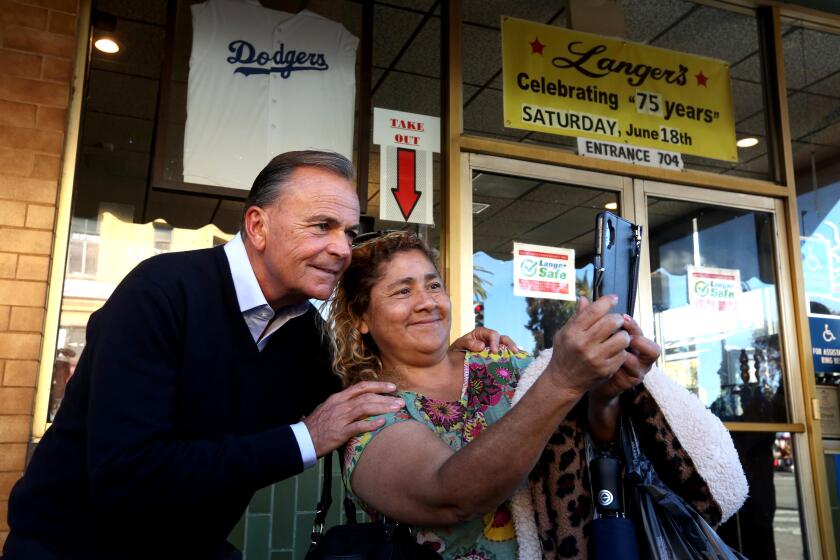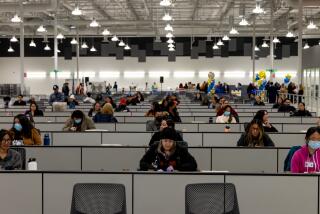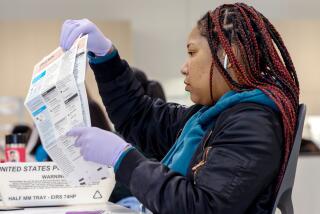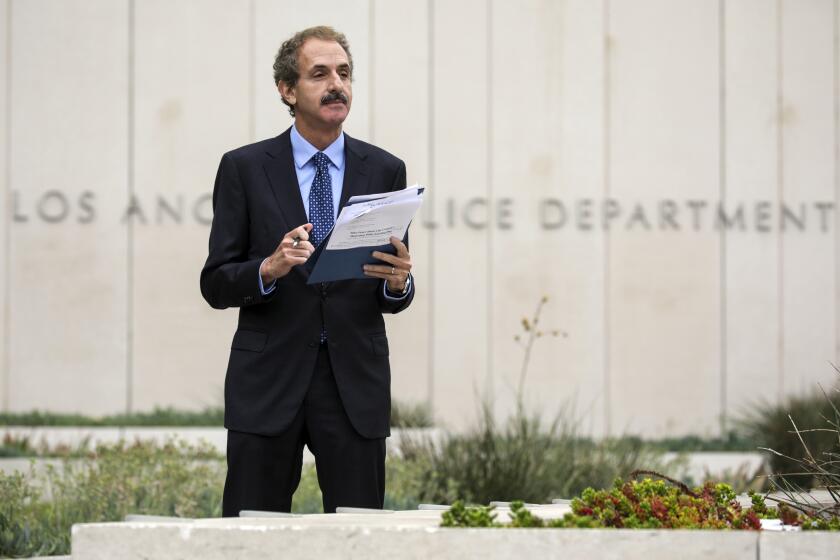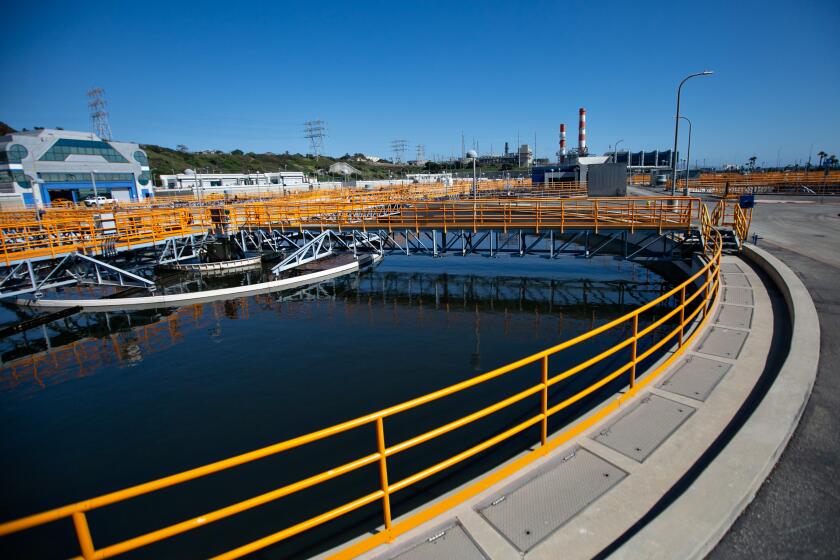Why it could take weeks to get final L.A. election results. ‘We aren’t sitting on ballots’
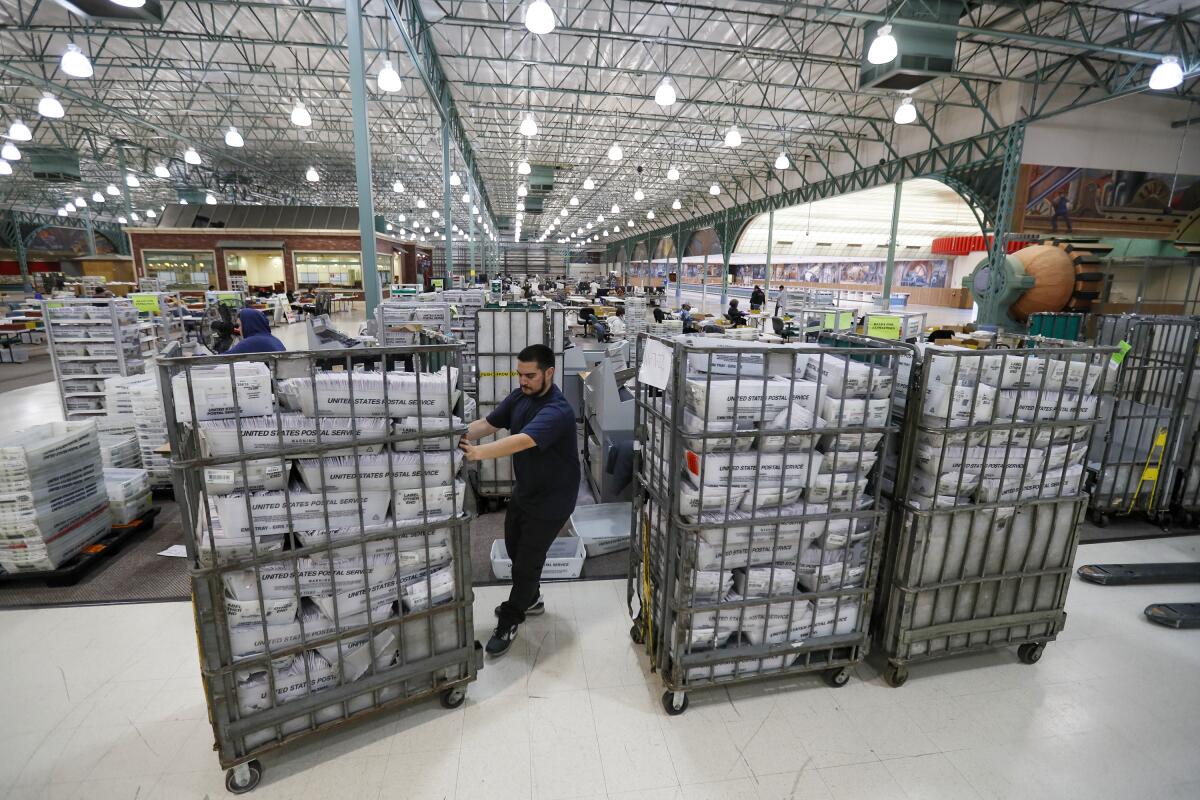
An adage known as the election administrator’s prayer goes something like this: “Dear Lord, let this election not be close.”
When results are overwhelmingly clear, there are far fewer doubts about the integrity of the election process or frustrations with the procedures.
But in Tuesday’s hotly contested Los Angeles mayor’s race between Rick Caruso and Karen Bass, as well as some down-ballot contests, the results are not overwhelmingly clear. In fact, it could take weeks to determine a winner in some races.
California’s shift to mail-in balloting means that voting begins weeks before election day and tabulation continues for weeks after, meaning results can remain murky in all but the most lopsided races immediately following an election.
Vote-by-mail ballots take longer to process, particularly when a massive number of them arrive all at once on election day, officials and experts said Wednesday. That makes the entire tabulation process lengthier, with less immediate certainty about how many ballots remain or whether the later tranches will look substantially different.
Analysts said the Los Angeles mayor’s race remained far too close to call, with as many as half the ballots remaining to be tabulated.
For the record:
8:24 a.m. Nov. 10, 2022An earlier version of this article said the county is scheduled to certify election results on Dec. 1. The correct date is Dec. 5.
Angelenos will probably have a better sense of where things stand in close races by next week — though tabulation will continue for several weeks, with the county scheduled to certify results Dec. 5.
“We aren’t sitting on ballots,” said county Registrar-Recorder/County Clerk Dean Logan, explaining that election officials had tabulated all the vote-by-mail ballots ready to be tallied in their possession by the wee hours Wednesday.
After election week, county election officials generally release new updates only twice a week, on Tuesdays and Fridays, though Logan said his office hadn’t ruled out the possibility of an additional update between those days, depending on the volume of ballots tallied.
“What I think we want to avoid is doing these incremental updates where things are bouncing back and forth, as opposed to getting substantial updates so we start to see the trends and the definition that’s taking place in the outcome,” Logan said.
In its final election-night release, just after 3:30 a.m. Wednesday, the county registrar-recorder’s office said it had counted 1,318,093 ballots — a total that includes all in-person voting and mail ballots received before election day, but not any of the mail ballots received on election day. Later Wednesday, the office estimated that 985,000 vote-by-mail ballots, 21,000 conditional voter registration ballots and several hundred provisional ballots were left to tabulate.
And the number of uncounted ballots will also continue to grow as more ballots arrive by mail. California law allows ballots postmarked by election day to be accepted for seven days.
Sealed containers of vote-by-mail ballots arrive at a county processing facility in the City of Industry, where they are verified and processed before being resealed and transported to a facility in Downey for tabulation.
“It really has to do with making sure that we go through the process of securely verifying those ballots, doing the extraction, doing the voter signature and getting them ready for tally,” Logan said. “Once they’re at tally, that process goes relatively quickly.”
Election experts describe California’s relatively slow vote counts as indicative of a working democratic process, in which every vote is counted and any possible fraud is being rooted out.
“It’s a little bit of do we want them to do their work or show their work,” Jessica Levinson, an election law professor at Loyola Law School, said of the desire for constant updates.
Shifts of workers at the county vote-by-mail facility in the City of Industry are verifying and processing ballots from 7 a.m. to 7 p.m., seven days a week, registrar-recorder spokesperson Mike Sanchez said.
“Part of this is about expectations,” Levinson said.
That point was echoed by Wändi Bruine de Bruin, a USC professor of public policy, psychology and behavioral science.
“If for decades our election outcomes were known the same night, then that’s what you expect,” Bruine de Bruin said, adding that people’s past experiences are often the biggest predictor of their expectations.
But norms about the timing of election results have been in flux for years. The shift stems from more than just the lengthier process for counting vote-by-mail ballots, said Jon Krosnick, a social psychologist and professor of psychology, political science and communication at Stanford University.
For decades, reliably accurate pre-election and exit polling helped shape election-night calls, giving news organizations and researchers a quicker picture of who would ultimately prevail as results were tabulated, Krosnick said.
Get the lowdown on L.A. politics
Sign up for our L.A. City Hall newsletter to get weekly insights, scoops and analysis.
You may occasionally receive promotional content from the Los Angeles Times.
But pre-election polling grew less accurate as the internet made cheaper online polling with non-random sampling more readily available. And exit polls don’t hold the weight they once did for a variety of reasons, Krosnick said.
Still, Krosnick emphasized that lengthy waiting periods for results were hardly unheard of in the past, citing the 2000 presidential election as a particularly notorious example.
“The older a voter is, the more they’re going to be used to instant gratification” on election night, Krosnick said. “The younger a voter is, the more they’ve lived in this newer world, where the networks are not making calls quickly, where the polls are not trusting predictors of the election and where voting by mail is prevalent.”
As a result, younger voters are less likely to be frustrated by a slower process, Krosnick said.
Kim Alexander, president of the nonpartisan California Voter Foundation, said the sheer number of L.A. County voters means the process is far more time-intensive here than in other counties.
People should “calm down and give the election staff time to do their job,” Alexander said.
More to Read
Start your day right
Sign up for Essential California for news, features and recommendations from the L.A. Times and beyond in your inbox six days a week.
You may occasionally receive promotional content from the Los Angeles Times.
